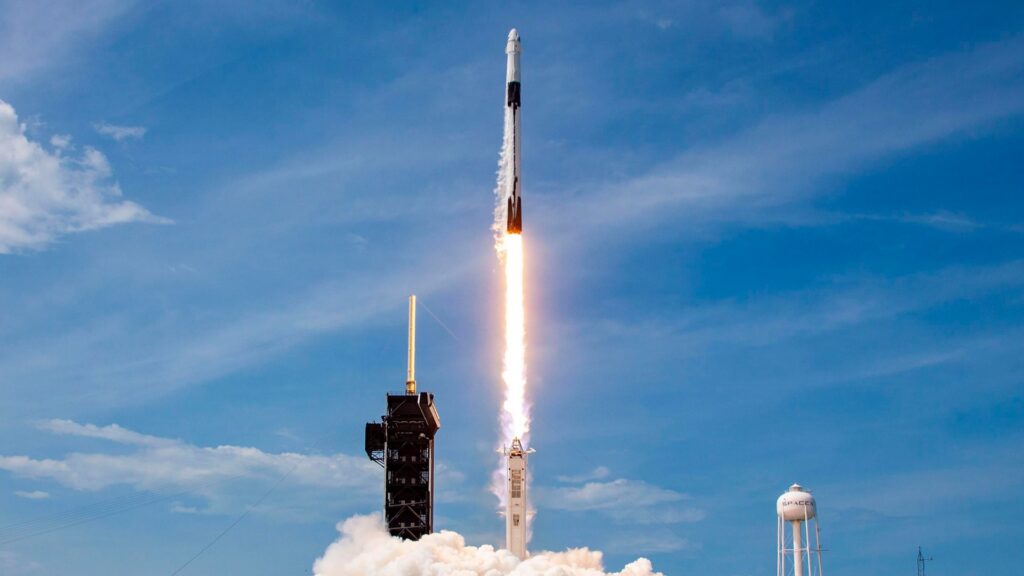SpaceX’s Falcon 9 rocket has successfully launched two lunar landers, Firefly Space’s Blue Ghost and ispace’s Resilience, from NASA’s Kennedy Space Center. This mission marks a significant step toward returning humans to the Moon, as part of NASA’s Artemis program scheduled for 2026.
SpaceX Launches Two Lunar Landers As It Gears Up To Take Humans Back On Moon Surface

Key Takeaways:
- SpaceX’s Falcon 9 launched Firefly Space’s Blue Ghost and ispace’s Resilience lunar landers.
- The missions are part of NASA’s Commercial Lunar Payload Services (CLPS) program.
- Blue Ghost will conduct science and technology demonstrations for NASA after a 45-day journey.
- Resilience will begin exploration activities on the Moon after a 4-5 month journey.
- These missions are precursors to NASA’s Artemis program aiming to return humans to the Moon in 2026.
SpaceX’s Falcon 9 Advances Lunar Exploration
SpaceX’s Falcon 9 rocket took another leap toward lunar exploration on Wednesday, launching two lunar landers bound for the Moon. The mission, carrying Firefly Space’s Blue Ghost and ispace’s Resilience landers, departed from NASA’s Kennedy Space Center in Florida, signaling a pivotal moment in the journey to return humans to the lunar surface.
Blue Ghost’s 45-Day Journey
Deployed into a lunar transfer orbit, the Blue Ghost lander embarked on an approximately 45-day journey to the Moon. Upon arrival, it will land on the lunar surface, where NASA’s payloads aboard will conduct a series of science and technology demonstrations. These experiments aim to provide valuable data on the lunar environment and test new technologies essential for future manned missions.
Resilience Prepares for Exploration
Meanwhile, ispace’s Resilience lander is set for a 4- to 5-month voyage before touching down on the Moon. Once on the surface, it will initiate exploration activities, further expanding our understanding of Earth’s closest celestial neighbor.
Significance for NASA’s CLPS Program
“Today’s mission is our third launch to a lunar surface and just the first of several our Falcon fleet will launch for NASA’s Commercial Lunar Payload Services (CLPS) program this year,” SpaceX announced on social media platform X. The CLPS program is designed to facilitate the delivery of scientific instruments and technology payloads to the Moon, laying the groundwork for future human exploration under NASA’s Artemis program.
Preparing for Artemis and Human Return
These robotic missions serve as precursors to the ambitious Artemis program, through which NASA plans to land astronauts on the Moon by September 2026, utilizing SpaceX’s Starship as the Human Landing System. The last human footsteps on the lunar surface were made in 1972 during the Apollo 17 mission. Since then, no crewed missions have ventured beyond low-Earth orbit.
Starship Development Continues
While the Starship remains in the testing and development phase—with six test flights completed and a seventh test flight scheduled—SpaceX continues to support lunar exploration through its reliable Falcon launch vehicles. The upcoming seventh test flight is slated for Wednesday at 4 p.m. CT, though SpaceX has noted that unfavorable weather conditions could lead to schedule adjustments.
Ongoing Lunar Commitment
As SpaceX advances both its Falcon and Starship programs, the recent launch underscores the company’s commitment to supporting NASA’s goal of returning humans to the Moon. The data and experience gained from these missions are crucial steps toward achieving sustained lunar presence and exploration.











